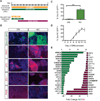Modeling neural crest induction, melanocyte specification, and disease-related pigmentation defects in hESCs and patient-specific iPSCs
- PMID: 23583175
- PMCID: PMC3681528
- DOI: 10.1016/j.celrep.2013.03.025
Modeling neural crest induction, melanocyte specification, and disease-related pigmentation defects in hESCs and patient-specific iPSCs
Abstract
Melanocytes are pigment-producing cells of neural crest (NC) origin that are responsible for protecting the skin against UV irradiation. Pluripotent stem cell (PSC) technology offers a promising approach for studying human melanocyte development and disease. Here, we report that timed exposure to activators of WNT, BMP, and EDN3 signaling triggers the sequential induction of NC and melanocyte precursor fates under dual-SMAD-inhibition conditions. Using a SOX10::GFP human embryonic stem cell (hESC) reporter line, we demonstrate that the temporal onset of WNT activation is particularly critical for human NC induction. Subsequent maturation of hESC-derived melanocytes yields pure populations that match the molecular and functional properties of adult melanocytes. Melanocytes from Hermansky-Pudlak syndrome and Chediak-Higashi syndrome patient-specific induced PSCs (iPSCs) faithfully reproduce the ultrastructural features of disease-associated pigmentation defects. Our data define a highly specific requirement for WNT signaling during NC induction and enable the generation of pure populations of human iPSC-derived melanocytes for faithful modeling of pigmentation disorders.
Copyright © 2013 The Authors. Published by Elsevier Inc. All rights reserved.
Figures







Similar articles
-
Induced pluripotent stem cell-derived melanocyte precursor cells undergoing differentiation into melanocytes.Pigment Cell Melanoma Res. 2019 Sep;32(5):623-633. doi: 10.1111/pcmr.12779. Epub 2019 Mar 25. Pigment Cell Melanoma Res. 2019. PMID: 30843370
-
Embryonic stem cells as a model for studying melanocyte development.Methods Mol Biol. 2010;584:301-16. doi: 10.1007/978-1-60761-369-5_16. Methods Mol Biol. 2010. PMID: 19907984
-
The transcription factors Ets1 and Sox10 interact during murine melanocyte development.Dev Biol. 2015 Nov 15;407(2):300-12. doi: 10.1016/j.ydbio.2015.04.012. Epub 2015 Apr 23. Dev Biol. 2015. PMID: 25912689 Free PMC article.
-
[Phenotypic plasticity of neural crest-derived melanocytes and Schwann cells].Biol Aujourdhui. 2011;205(1):53-61. doi: 10.1051/jbio/2011008. Epub 2011 Apr 19. Biol Aujourdhui. 2011. PMID: 21501576 Review. French.
-
The making of a melanocyte: the specification of melanoblasts from the neural crest.Pigment Cell Melanoma Res. 2008 Dec;21(6):598-610. doi: 10.1111/j.1755-148X.2008.00506.x. Pigment Cell Melanoma Res. 2008. PMID: 19067969 Review.
Cited by
-
Dynamic 3D Combinatorial Generation of hPSC-Derived Neuromesodermal Organoids With Diverse Regional and Cellular Identities.Curr Protoc. 2022 Oct;2(10):e568. doi: 10.1002/cpz1.568. Curr Protoc. 2022. PMID: 36264199 Free PMC article.
-
An integrated in vitro human iPSCs-derived neuron and in vivo animal approach for preclinical screening of anti-seizure compounds.J Adv Res. 2024 Oct;64:249-262. doi: 10.1016/j.jare.2023.11.022. Epub 2023 Nov 22. J Adv Res. 2024. PMID: 37995945 Free PMC article.
-
Modeling Varicella Zoster Virus Persistence and Reactivation - Closer to Resolving a Perplexing Persistent State.Front Microbiol. 2019 Jul 24;10:1634. doi: 10.3389/fmicb.2019.01634. eCollection 2019. Front Microbiol. 2019. PMID: 31396173 Free PMC article. Review.
-
iPSC-derived cranial neural crest-like cells can replicate dental pulp tissue with the aid of angiogenic hydrogel.Bioact Mater. 2021 Nov 24;14:290-301. doi: 10.1016/j.bioactmat.2021.11.014. eCollection 2022 Aug. Bioact Mater. 2021. PMID: 35310357 Free PMC article.
-
AP-1 transcription factor network explains diverse patterns of cellular plasticity in melanoma cells.Cell Rep. 2022 Aug 2;40(5):111147. doi: 10.1016/j.celrep.2022.111147. Cell Rep. 2022. PMID: 35926467 Free PMC article.
References
-
- Adameyko I, Lallemend F, Aquino JB, Pereira JA, Topilko P, Müller T, Fritz N, Beljajeva A, Mochii M, Liste I, et al. Schwann cell precursors from nerve innervation are a cellular origin of melanocytes in skin. Cell. 2009;139:366–379. - PubMed
-
- Baynash AG, Hosoda K, Giaid A, Richardson JA, Emoto N, Hammer RE, Yanagisawa M. Interaction of endothelin-3 with endothelin-B receptor is essential for development of epidermal melanocytes and enteric neurons. Cell. 1994;79:1277–1285. - PubMed
-
- Braun MM, Etheridge A, Bernard A, Robertson CP, Roelink H. Wnt signaling is required at distinct stages of development for the induction of the posterior forebrain. Development. 2003;130:5579–5587. - PubMed
-
- Bronner-Fraser M. Analysis of the early stages of trunk neural crest migration in avian embryos using monoclonal antibody HNK-1. Developmental biology. 1986;115:44–55. - PubMed
Publication types
MeSH terms
Substances
Associated data
- Actions
Grants and funding
LinkOut - more resources
Full Text Sources
Other Literature Sources
Molecular Biology Databases

